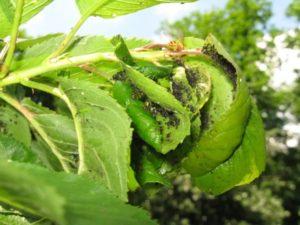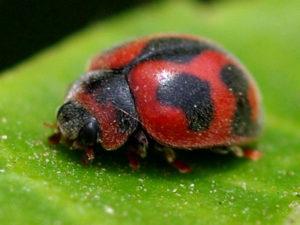Ladybug and aphid: an example of the relationship between predator and prey
Experienced gardeners know firsthand what harm a tiny aphid can do to a crop. Dealing with this dangerous pest can be very difficult. Especially for those who oppose the use of chemicals. In such cases, people often resort to the help of the main natural enemies of aphids - ladybugs.
Content
How dangerous are aphids
In favorable conditions, the number of aphid colonies can increase very quickly. Because of this, the beds that the gluttonous family will flood can be completely destroyed in a short time.
Aphids that settled on the site pose a serious threat to young seedlings, bushes, trees, as well as indoor and outdoor flowers. It quickly spreads from one plant to neighboring ones.
Most often, this small pest harms the following crops:
- cucumbers;
- tomatoes;
- currant;
- apple trees;
- plums;
- pears;
- roses;
- lilac;
- violets.
What is the relationship between ladybug and aphids?
Ladybugs are the real predators in the world of insects. Their diet consists mainly of:
- small caterpillars;
- spider mites;
- aphids.
The latter is the most favorite delicacy of these red bugs, so it is they who destroy the bulk of the small pest in the beds.
It is worth noting that aphids are actively eaten not only by adult ladybugs, but also by their larvae. Therefore, the fact that the ladybug is the worst enemy of aphids is undeniable.
How long ago did people start using ladybugs to control aphids?
For the first time, scientists became interested in the diet of ladybugs in the early 19th century. During this period, an Australian species of a dangerous pest, the fluffy shield aphid, was accidentally introduced to the territory of North America.
Once in comfortable conditions, these small pests very quickly mastered local citrus plantations and began to rapidly destroy the crop.
It was during this difficult time that the decision was made to use ladybugs to fight aphids, namely the species Rodolia cardinalis, which was also home to Australia. After 2 years of hard work of "solar" bugs, the invasion of pests was stopped.
How to attract aphids to the site
In the diet of ladybugs, there are not only other insects, but also pollen from various plants. To lure helpers to their site, people began to plant those plants that most attract red bugs:
- cornflowers;
- calendula;
- geranium;
- dandelion;
- dill;
- coriander;
- mint;
- yarrow;
- fennel;
- a series of.
Also popular ways to attract such helpers are the use of pheromone baits and self-settlement in the garden of bugs bought in a store or caught in other areas.
An interesting fact is that in the second half of the 20th century, the practice of dropping ladybugs on the fields from airplanes was common.
What types of ladybugs are the most dangerous in pest control
The most common representative of the ladybug family in Russia is the seven-spot ladybug. The children calmly caught bugs of this particular type with their hands and then let them out “on the sky”. Despite their friendliness, they are also predators and eat aphids.
But, if we are talking about efficiency, then among the "cows" there is one particularly aggressive species, which is considered much more voracious than the rest. This harlequin ladybug or Asian ladybug. In the last century, this species was specially bred in many countries to combat the invasion of aphids, and thanks to its "brutal" appetite, it coped with the task in just a couple of years. At the same time, the harlequin cow even exceeded the expectations of the breeders, as it began to actively eat other insects, including useful ones.
Conclusion
Ladybugs of almost all kinds are unambiguously true allies of man in the war against aphids. These small bugs have controlled the number of colonies of a dangerous pest for many years and annually save a huge number of beds from death.
Therefore, having met ladybugs on young seedlings, you should not drive them away. At this moment, they do not gnaw the leaves and shoots of plants, but save them from a small dangerous pest, which is sometimes very difficult to notice.
Previous

